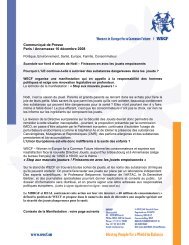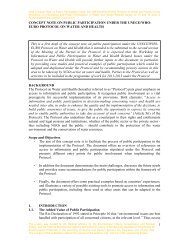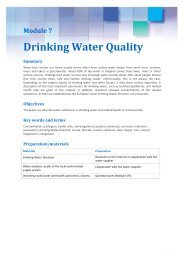<strong>Sustainable</strong> <strong>and</strong> <strong>cost</strong>-<strong>effective</strong> <strong>wastewater</strong> treatment <strong>systems</strong> <strong>for</strong> <strong>rural</strong> <strong>and</strong> peri-urban communities up to 10,000 PE2. <strong>Sustainable</strong> <strong>and</strong> <strong>cost</strong>-<strong>effective</strong> <strong>wastewater</strong> treatment <strong>systems</strong> which meet the requirements of the UWWTD2.3.1 Wastewater PondsFrance 1998Treatment plants <strong>for</strong> 1,000 PE 8Germany 2000Treatment plants<strong>for</strong> 1,000 PE 9Wastewater treatment in ponds or lagoons is a well known technology. The extensive treatment processrelies on suspended bacterial growth cultures. The purification is ensured thanks to long retentiontime which requires a lot of space compared to intensive <strong>systems</strong>. Pond <strong>systems</strong> are a high-per<strong>for</strong>mance,low-<strong>cost</strong>, low-energy (often zero-energy) <strong>and</strong> low-maintenance treatment process, especiallysuitable in warm climates.Pond <strong>systems</strong> are well established technology in the EU <strong>and</strong> are widely used in the <strong>rural</strong> areas of mostcountries. In France, there are more than 2,500 waste stabilization pond <strong>systems</strong> in operation.Two different <strong>systems</strong> are considered here: the waste stabilization pond <strong>and</strong> the aerated pond system.Treatment process Investment <strong>cost</strong>s Euro/PE Annual operational <strong>cost</strong>s Euro/PE Investment <strong>cost</strong>s Euro/PEAdvantages DrawbacksIntensive technicaltreatmentActivated sludgesystemRotating biologicalcontactorBiofilterExtensivetreatmentImhoff tank +Constructed wetl<strong>and</strong>Aerated pondWaste stabilizationpond230 ± 30%220 ± 45%180 ± 50%190 ± 35%130 ± 50%120 ± 60%11.5775.56.54.5380320200• Low <strong>cost</strong> technology• Low or no energy dem<strong>and</strong> (in case of wastestabilization ponds)• Simple operation <strong>and</strong> maintenance• No electromechanical machinery(in case of waste stabilization ponds)• Adapts well to large variations in hydraulic load• Good elimination of pathogenic organisms in summer<strong>and</strong> winter <strong>and</strong> in winter• Partly removal of nutrients• Integrates well into the l<strong>and</strong>scape• Absence of noise pollution• Sewage sludge to be taken out of the pond iswell stabilized• Can be applied <strong>for</strong> on-site, semi-centralized<strong>and</strong> centralized concepts: storage of run-off rainwateris possible• Much space required• Per<strong>for</strong>mance is less than in intensive processes with respect toorganic matter. However the discharge takes place in the <strong>for</strong>mof algae which has less adverse effects than dissolved organicmatter. The discharge is low in summer which is the most unfavorableperiod <strong>for</strong> water courses• May generate odor• Energy consumption (in case of aerated ponds)• Elimination rate is reduced at cold temperatureTable 5: Investment <strong>and</strong> annual operational <strong>cost</strong>s of treatment plantsTable 6: Advantages <strong>and</strong> drawbacks of pond <strong>systems</strong>Looking at <strong>cost</strong>s <strong>for</strong> the different technologies, it is always difficult to properly compare the conditionsof the treatment plants. Table 5 gives a few figures <strong>for</strong> treatment plants (1,000 PE) in France <strong>and</strong> Germany.In relation, the extensive technologies have major advantages in terms of <strong>cost</strong>s <strong>for</strong> both investment<strong>and</strong> operation. All of them are able to meet the requirements of the UWWTD. If nutrient removalis required in case of effluent discharge into sensitive areas, extensive technologies are also possibleoptions when properly designed <strong>and</strong> operated.A significant benefit is the per<strong>for</strong>mance of pathogen removal which is much higher than <strong>for</strong> the extensive<strong>systems</strong>. Although the hygienic criterium is not required by the UWWTD, it is important esp. <strong>for</strong>public health <strong>and</strong> re-use purpose. The extensive technologies have in common that they can be operatedwithout electricity (exception is the aerated pond).Based on the overview presented in table 4 <strong>and</strong> 5, the extensive treatment options as well as theanaerobic reactor can be considered as more sustainable in <strong>rural</strong> areas than the intensive options.The extensive techniques are going to be explained in more detail in the coming sub-chapters <strong>and</strong> casestudies will be shown in the last chapter.Waste stabilization ponds (natural ponds)The treatment in stabilization or natural pond <strong>systems</strong> is taking place in several water tight basinsplaced in series.Design of the pond systemThe system typically comprises three ponds in serie: one facultative pond (sized at 6 m 2 per PE) <strong>and</strong> twomaturation ponds (each 2.5 m 2 per PE).A serie of 3 ponds ensures a reliable removal of organic matter, partly removal of nutrients <strong>and</strong> partlydisinfection. In order to achieve safe nitrogen removal or disinfection, additional ponds up to a serie oftotal 6 are required.In front of the first pond, it is useful to install a device to remove floating solids. In smaller plants withless than 500 PE, it is possible to use a mobile suction barrier to retain floating solids. In bigger plants, abar screen should be installed in front.14 158 FNDAE technical document No 22, 1998, taken from Extensive Wastewater Treatment Processes adapted to small <strong>and</strong> medium sized communities (500 –5,000 PE)” see http://ec.europa.eu/environment/water/water-urbanwaste/info/pdf/waterguide_en.pdf9 Halbach (2000) Abwasserkosten für ostdeutsche Kommunen und Verbände, Institut für Abwasserwirtschaft Halbach
<strong>Sustainable</strong> <strong>and</strong> <strong>cost</strong>-<strong>effective</strong> <strong>wastewater</strong> <strong>systems</strong> <strong>for</strong> <strong>rural</strong> <strong>and</strong> peri-urban communities up to 10,000 PE2. <strong>Sustainable</strong> <strong>and</strong> <strong>cost</strong>-<strong>effective</strong> <strong>wastewater</strong> treatment <strong>systems</strong> which meet the requirements of the UWWTDFigure 2: Schemativ top view on a waste stabilization pond system(drafted from: EU guide „Extensive <strong>wastewater</strong> treatment processes“)Aerated pond Schlamerdorf, Germany1. facultative pondThe first pond step is designed to remove the major part of organic matter. The design criteria of 6 m 2per PE is commonly used which corresponds to a surface load of around 8 g/m 2 BOD. In case of varyingseasonal loads e.g. due to tourism, the design should be made based on monthly peak flows. The depthof the first pond is 1-2 m.As first pond, Mara (1998) also recommends an anaerobic pond which can be built more than 3 m deep.To avoid methane emissions, it must be covered <strong>and</strong> the generated biogas can be collected.Aerated pondsTo enhance the treatment, a technical aeration by surface aerator or air blower can be introduced intoa pond system. The system is then very close to the intensive system of activated sludge reactorwithout sludge recycling. The energy consumption can be as high as <strong>for</strong> activated sludge <strong>systems</strong>.Design of the pond systemThis system typically comprises two ponds in serie <strong>and</strong> three ponds in total: one aerated pond2. <strong>and</strong> 3. maturation pondMaturation ponds are designed <strong>for</strong> the removal of nutrients (N <strong>and</strong> P) <strong>and</strong> pathogens. The design criteriaare each 2.5 m 2 per PE. Depths of the maturation ponds are typically 1 m. The shape of the maturationponds can be integrated into the l<strong>and</strong>scape.Per<strong>for</strong>mance of the waste stabilization pond systemThe results in terms of organic matter achieve more than 75% COD removal which corresponds to afiltered COD concentration of less than 125 mg/l.The concentrations in total nitrogen in the effluent are very low <strong>and</strong> can meet st<strong>and</strong>ards <strong>for</strong> sensitiveareas in summer but due to low temperature the per<strong>for</strong>mance is reduced in winter. This is however alsothe case <strong>for</strong> intensive processes.The reduction in phosphorus is higher than 60% in the first 10-20 years <strong>and</strong> might decrease due to releaseof phosphorus from the sediment (settled sludge) again.Disinfection is important especially when discharging to small receiving waters in summer. The per<strong>for</strong>manceof more than factor 1000 is better than with intensive <strong>systems</strong> due to high retention time <strong>and</strong>UV radiation effects by the sun.Reference <strong>for</strong> the design of waste maturation ponds:• Mara, D.D. <strong>and</strong> Pearson, H.W. (1998) Design Manual <strong>for</strong> Waste Stabilization Ponds in MediterraneanCountries. Lagoon Technology International, Leeds• Agences de Bassins (1979) Lagunage naturel et lagunage aéré: procédés d`épuration des petitescollectivités, CTGREF d Aix en Provence.• DWA A-201 (2005) Principles <strong>for</strong> the dimensioning, construction <strong>and</strong> operation of <strong>wastewater</strong> ponds,German Association <strong>for</strong> Water, Wastewater <strong>and</strong> Waste.Figure 3: Schemativ top view on a aerated pond system (drafted from: EU guide„Extensive <strong>wastewater</strong> treatment processes“)Be<strong>for</strong>e the pond, it is useful to install a device to remove floating solids. In smaller plants with less than500 PE, it is possible to use a mobile suction barrier to retain floating solids. In bigger plants, a bar screenshould be installed in front.1. aerated pondIn this main pond with technical aeration, the treatment is similar to an intensive treatment. Howeverthe density of bacteria is much lower <strong>and</strong> the retention time is longer with around 20 days. The totaldesign volume is 3 m 3 per PE <strong>and</strong> the depth 2-3.5 m with surface aerator <strong>and</strong> more than 4 m with airblower. The requirement of oxygen is 2 kg O 2 /kg BOD. In order to mix the volume <strong>and</strong> to prevent <strong>for</strong>mationof micro algae it is necessary to use a power level between 3 <strong>and</strong> 6 kW/m 3 .16 17
















